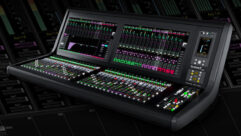Don’t guess at it, VOM it
Mar 20, 1997 12:00 PM,
Glen Ballou
One of the most important tools we can keep in our tool box is a VOM (volt-ohm-milliampmeter) or, in today’s terms, a multimeter. Multimeters are used to measure AC and DC voltage, DC resistance and DC current.
Years ago multimeters were either VOMs or VTVMs (vacuum-tube volt meters.) Today multimeters come in two basic forms, analog and digital, each with its own advantages and disadvantages, although the rage is digital multimeters (DMM). (See Figure 1 and Figure 2.) DDMs are easy to read under good conditions, normally more accurate and usually more rugged because they do not have a jeweled meter in them. Of course, the standard saying about DDMs is, “I never knew how inaccurate my meter was until I paralleled it with a second DDM, and they didn’t read the same.” But in our field, we very seldom need accuracy to the last digit and beyond.
DDM strong points include easy-to-read static voltages, current and resistance, and they often can make measurements analog meters can’t. For instance, many midpriced digital multimeters also measure diodes, transistor gain, AC current, frequency, capacitance and temperature, and they may even include a graphic panel. As far as weak points, it is difficult to follow trends unless they include a graphic panel, and they often have a long settling time. DMMs often require decent light on the meter face and a fairly straight-on viewing angle.
Analog multimeters show variations in the measurement we are making because the pointer follows slow changes in the measurement. (See Figure 3.) This feature can be useful when two signals are beating. By counting the number of times the meter swings and dividing it by time, we can determine the frequency difference between the signals.
Analog multimeters are often easier to read in hard-to-get areas. With an analog meter, all we need is to see the meter pointer, and then we can estimate where it is on the meter face; therefore, when in the bowels of a building with just enough room to fit a meter, your hands and head, an analog meter is the meter of choice.
It is important to know the meter window material. Glass windows are the best, if we are careful not to break them, because they do not scratch easily and are statically inert. Plastic windows don’t readily shatter but they do scratch easily and, more importantly, they hold a static charge. A static charge usually stops the pointer from returning to zero or reaching its destination. If I think the window is charged, I watch the meter movement as it swings. If the meter is operating OK, the meter action is smooth, and the pointer comes to its destination with a little overshoot or at least slows down as it reaches equilibrium. If it is charged, the meter will swing and stop instantly. If this occurs, the reading is inaccurate.
Like any piece of test gear, multimeters can’t just be hung on a couple of lines and the results read. We must know what we want to measure, if it can be measured with the meter and how safe is it to measure it, i.e., will the meter or the operator come out second best?
What do we measure and how do we measure it with multimeters? When installing a system, the first thing I always do is measure the house power. High voltage — anything above the manufacturer’s recommendation — can cause failure or at least overheating. Low voltage can cause motors to stall and overheat and can cause amplifiers to produce distortion and low power. Remember, when measuring house power, to have the meter on AC voltage and on a scale higher than what you expect to measure.
An auto-ranging meter will set the scale for us but not the function. First measure voltage between the neutral and ground, then between hot and neutral and finally between hot and ground. (If any voltage is between neutral and ground on 120 V systems, I stop measuring and call an electrician. Don’t plug into it!) After we have the system plugged in and turned on, I measure the voltage again. It should still be the same voltage it was without a load. If not, call the electrician because a voltage drop means there is resistance in the power line.
Before connecting the loudspeaker lines to the amplifier, I always measure them. Of course an impedance meter is the best way, but a multimeter is the next best thing. To measure the loudspeaker line, set the meter to ohms. Always disconnect loudspeaker lines from the amplifier before measuring them because amplifier output impedance is low, which will give bad readings. Also, if the amplifier is turned on, it can damage the meter. Most 8 V loudspeakers read in the vicinity of 6 V DC. If three loudspeakers are connected in parallel, the meter would read 2 V.
Of course, if the loudspeaker runs are long and the wire gauge is small, the wire resistance will also be added to the reading. If I expect a problem with the wire, I short it at the loudspeaker and measure it at the amplifier end, which measures the resistance of the wire by itself. If the amplifier is feeding a constant voltage such as a 70.7 V system, the DC resistance will probably be quite low, but never 0 V. If the measurement appears OK, check both sides of the line to ground. If either side is shorted to ground, fix it before operating the system; after all, the shorted side could get connected to the high side of the amplifier output, shorting the amplifier output. And, if nothing else, a grounded line can cause ground loops.
It is always good to check the microphone cables the same way you check the loudspeaker lines to be sure you don’t have any shorts, opens or unwanted grounds.
If I see an unwanted DC voltage on a line, I check for leaky capacitors or, if it’s a microphone circuit, I check to see if the phantom power is on. If I have an unwanted AC voltage, I use the frequency measuring portion of the DMM to determine whether it is high-frequency oscillation or 60 Hz noise. High-frequency oscillation usually ends up overheating amplifiers and does not do loudspeakers any good.
The resistance portion of the meter can be used to check a diode, although it is much faster and easier to use the diode checker feature. This feature tells the voltage drop across the diode so we can determine whether it is a silicon or germanium diode.
Multimeters are also the meter of choice for measuring electronic circuits. They measure circuit voltages and currents and, when the electronics are turned off, resistance. We must take certain things into account when using multimeters to measure electronic circuits.
Different meters have different input impedances. VOMs usually have a relatively low input impedance, which is given in V/V. This impedance could range from 1,000 V/V to 20,000 V/V or more full scale. DMMs are high-input impedance devices and do not normally affect the circuit being measured.
If a VOM measures voltage of a high-impedance circuit, the meter impedance can affect the measurement. For instance, if you are measuring the voltage across a high-impedance voltage divider, a low-impedance meter will change the ratio of the divider. (See Figure 4.) This divider could be the bias circuit of a tube, transistor, FET or IC. If a VOM is used to measure 4.5 V on a 5 V scale, the input impedance of a 1,000 V/V meter would be 5,000 V (1,000 V/V — 5 V.) If the same voltage was measured on the 50 V scale, the input impedance would be 50,000 V, but, because VOM accuracy is usually given as % full scale, the reading would be so low on the scale it would be less accurate.
For instance, if the meter has an accuracy of 2% full scale, it could read ±2 V at 100 V on the 100 V scale. If we are using the same scale to read 10 V, we could still be off ± 2% full scale or ±2 V, not ± 2% of 10 V or 0.2 V. Our reading could be off 20%, not 2%. This condition does not occur with DMMs because their impedance is constant and accuracy is given as a basic accuracy for all readings. As we can see, it is important to know our meter and its limitations.
Multimeters are a most important piece of any tool box, so don’t leave home without one.
Ballou is with Innovative Communications in Guilford, CT.









